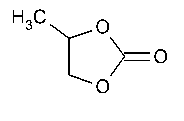Propylene Carbonate
»Propylene Carbonate contains not less than 99.0percent and not more than 100.5percent of C4H6O3.
Packaging and storage—
Preserve in tight containers.
Identification—
Infrared Absorption á197Fñ.
Specific gravity á841ñ:
between 1.203and 1.210at 20 .
.
pHá791ñ—
Gently but thoroughly mix 10mLwith 0.3mLof saturated potassium chloride solution in a 100-mLborosilicate volumetric flask.Dilute with carbon dioxide-free water having a pHof 7.0±0.5to volume.Completely purge the solution by vigorous nitrogen bubbling,and continue the bubbling during the pHmeasurement.Determine the pHpotentiometrically when the reading stabilizes:it is between 6.0and 7.5.
Residue on ignition á281ñ:
not more than 0.01%.
Organic volatile impurities,Method Iá467ñ:
meets the requirements.
Assay—
Barium hydroxide solution—
Dissolve 75g of barium hydroxide (octahydrate)in 1Lof water.Filter before using.
Procedure—
Flush a 250-mLiodine flask with nitrogen to expel the air,and insert the stopper in the flask to exclude carbon dioxide.Transfer 50.0mLof Barium hydroxide solutionand about 600mg of Propylene Carbonate,accurately weighed,to the flask,and loosely reinsert the stopper.Moisten the stopper with 3drops of water,and heat the flask on a steam bath for 10minutes.Remove the flask from the steam bath,add 6drops of phenolphthalein TS,and titrate while hot with 0.5Nhydrochloric acid VSuntil only a trace of pink color remains.Perform a blank determination,using the same Barium hydroxide solution.Each mLof 0.5Nhydrochloric acid consumed is equivalent to 25.52mg of C4H6O3.
Auxiliary Information—
Staff Liaison:Catherine Sheehan,B.Sc.,Scientist
Expert Committee:(EMC)Excipients:Monograph Content
USP28–NF23Page 3068
Phone Number:1-301-816-8262
